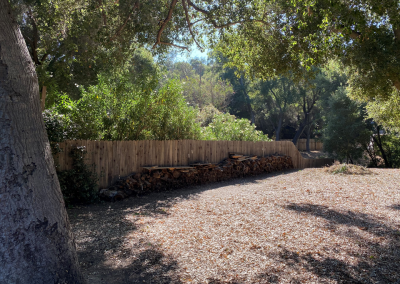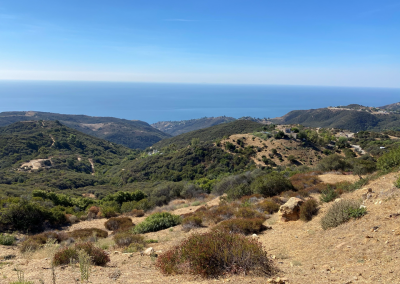The Home Ignition Zone Evaluation Program (HIZEP), initially developed in 2012 by the North Topanga Canyon Fire Safe Council, is an extremely successful, at-your-home evaluation aiming to improve awareness and foster better management of the defensible space zone. This zone refers to the space around the structure of your home, typically extending to the first 100 feet. Starting in September 2020, the RCD expanded HIZEP to allow more homeowners in a wider area to participate.
The Los Angeles County Fire Department estimates that embers caused the ignition of over 50% of the homes that burned in recent wildfires. Carried by strong winds, embers rain down on vulnerable homes and their surroundings, often miles ahead of flames. Once homes ignite, they create intense heat and more embers that can ignite other nearby properties. This turns what would be a fast-moving vegetation fire into a multi-structure inferno, putting entire neighborhoods at risk — and making it exceedingly dangerous for vital first responders to enter the area and protect the remaining structures.
A home ignition zone evaluation is an assessment of the vulnerability of your house and landscape to wildfire and ember-ignition. During this assessment, an evaluator will make specific home hardening and defensible space recommendations based on your property. Evaluations are performed by trained volunteers and RCD staff and take about 60 to 90 minutes to complete. A summary of all the recommendations – taking into account budget considerations – is provided at the end of the evaluation. The homeowner is under no obligation to complete any of the recommendations, though we will follow up to inquire as to whether the homeowner addressed any improvements, and if not, what barriers to completion they encountered. The information collected will help determine what incentive programs should be developed to help homeowners complete ignition-resistant improvements. Until grant funds for this program are exhausted this service will be provided free of charge, and afterward at a fee. Interested homeowners should get in touch right away to schedule an evaluation.
Thus far, the RCD and volunteers have performed roughly 60 evaluations in Topanga, Pacific Palisades, Calabasas, Agoura Hills and West Hills. One of the most common vulnerabilities observed was inadequate ember protection on house vents. All vents should be mitigated with a 1/8” mesh screen to prevent wind-blown ember intrusion from igniting a structure from within. Improper vegetation within the first 5 feet around the house was also a recurring issue, putting vulnerable windows and wood structures – such as open-eaves – at risk. Fire-resistant upgrades can be costly (i.e., replacing a roof or boxing in eaves), but you can significantly reduce the risk of ignition through routine maintenance alone. Pay special attention to where vegetation debris tends to accumulate on and around your home.
In late 2020 the RCD – in collaboration with local and state organizations – published a new online platform presenting compelling diagrams for home hardening and fire-wise landscaping best practices that support home ignition resistance and habitat conservation. People can dig into this mine of information by going to www.defensiblespace.org.
To learn more about the program and to sign up for an evaluation, go to the RCD’s website and look for Home Ignition Zone Evaluations under Services. You can book an evaluation using the automated system or directly contact our Community Resilience Coordinator.


